“A booster for the most powerful rocket in the world, NASA's Space Launch System (SLS), successfully fired up Tuesday for its second qualification ground test at Orbital ATK’s test facilities in Promontory, Utah. This was the last full-scale test for the booster before SLS's first uncrewed test flight with NASA's Orion spacecraft in late 2018, a milestone on the agency's Journey to Mars. “This final qualification test of the booster system shows real progress in the development of the Space Launch System”, said William Gerstenmaier, associate administrator for the Human Exploration and Operations Mission Directorate at NASA Headquarters in Washington. “Seeing this test today, and experiencing the sound and feel of approximately 3.6 million pounds of thrust, helps us appreciate the progress we're making to advance human exploration and open new frontiers for science and technology missions in deep space”. The booster was tested at a cold motor conditioning target of 40 degrees Fahrenheit – the colder end of its accepted propellant temperature range. When ignited, temperatures inside the booster reached nearly 6,000 degrees. The two-minute, full-duration ground qualification test provided NASA with critical data on 82 qualification objectives that will support certification of the booster for flight. Engineers now will evaluate the data, captured by more than 530 instrumentation channels on the booster”. – NASA
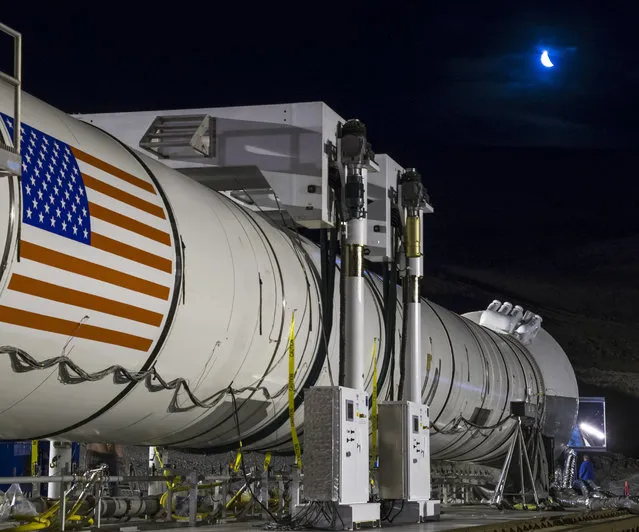
The moon rises ahead of the second and final qualification motor (QM-2) test for the Space Launch System's booster, Tuesday, June 28, 2016, at Orbital ATK Propulsion Systems test facilities in Promontory, Utah. During the Space Launch System flight the boosters will provide more than 75 percent of the thrust needed to escape the gravitational pull of the Earth, the first step on NASA's Journey to Mars. (Photo by Bill Ingalls/NASA via AP Photo)
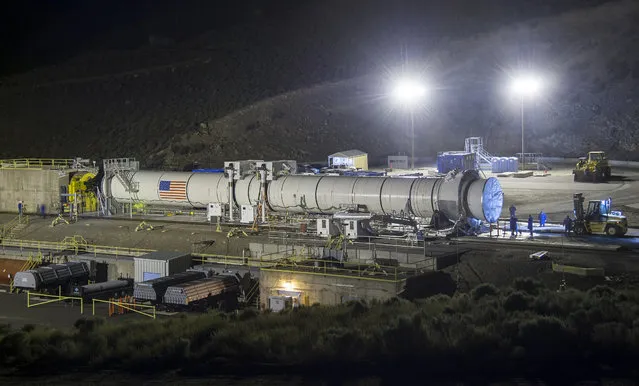
The Space Launch System's booster is seen a few hours ahead of the second and final qualification motor (QM-2) test, Tuesday, June 28, 2016, at Orbital ATK Propulsion Systems test facilities in Promontory, Utah. (Photo by Bill Ingalls/NASA via AP Photo)
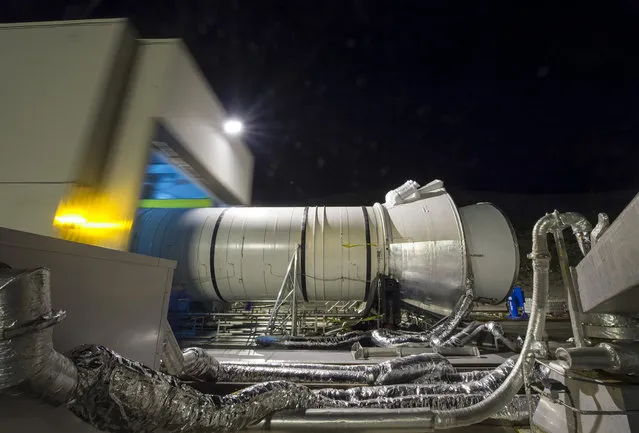
The booster house is rolled back ahead of the second and final qualification motor (QM-2) test for the Space Launch System's booster, Tuesday, June 28, 2016, at Orbital ATK Propulsion Systems test facilities in Promontory, Utah. (Photo by Bill Ingalls/NASA via AP Photo)
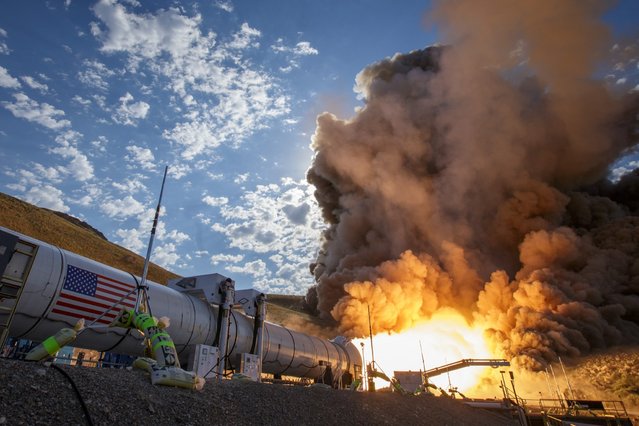
The second and final qualification motor (QM-2) test for the Space Launch System's booster, June 28, 2016, at Orbital ATK Propulsion Systems test facilities in Promontory, Utah. (Photo by Bill Ingalls/NASA)
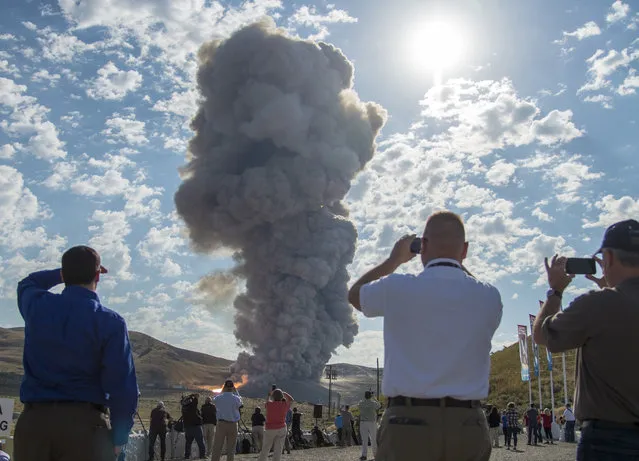
Spectators watch the second and final qualification motor (QM-2) test for the Space Launch System's booster, Tuesday, June 28, 2016, at Orbital ATK Propulsion Systems test facilities in Promontory, Utah. (Photo by Bill Ingalls/NASA via AP Photo)
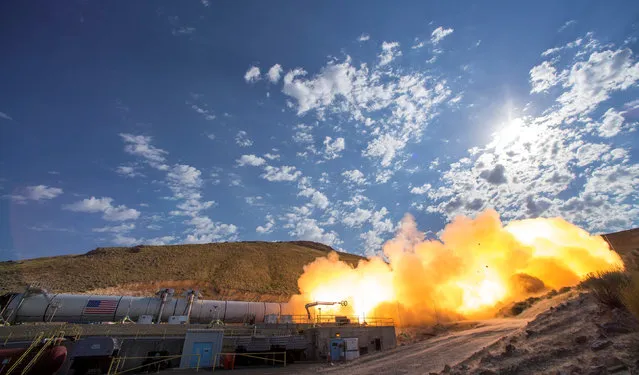
The SLS Five-Segment Solid Rocket Motor, that will launch NASA’s Space Launch System and Orion spacecraft to deep space, undergoes a static test fire at the Orbital ATK facility in Promontory, Utah, U.S., in this June 28, 2016 handout photo. (Photo by Bill Ingalls/Reuters/NASA)
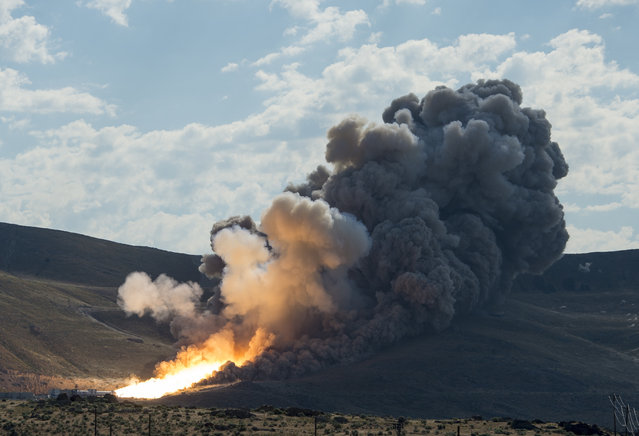
A handout image released by NASA on 28 June 2016 shows the second and final qualification motor (QM-2) test for the Space Launch System's booster, at Orbital ATK Propulsion Systems test facilities in Promontory, Utah, USA, 28 June 2016. During the Space Launch System flight the boosters will provide more than 75 percent of the thrust needed to escape the gravitational pull of the Earth, the first step on NASA's Journey to Mars. (Photo by Bill Ingalls/EPA/NASA)
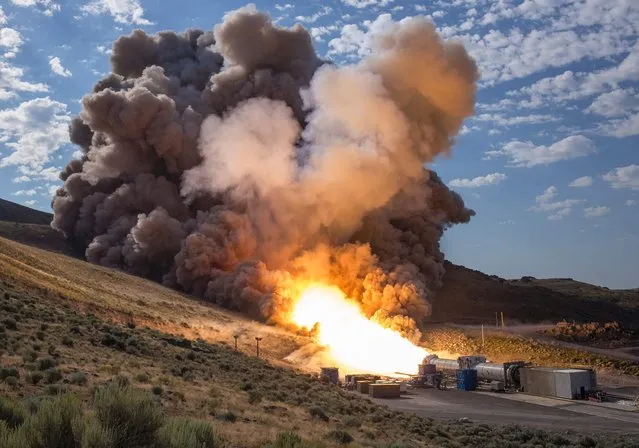
The second and final qualification motor (QM-2) test for the Space Launch System's booster is seen June 28, 2016, at Orbital ATK Propulsion Systems test facilities in Promontory, Utah. During the Space Launch System flight the boosters will provide more than 75 percent of the thrust needed to escape the gravitational pull of the Earth, the first step on NASA's Journey to Mars. Fire and gray smoke billowed from the booster, which lay on the ground during the two-minute test fire in the remote hills of Utah at 11:05 am (1605 GMT). (Photo by Bill Ingalls/AFP Photo/NASA)
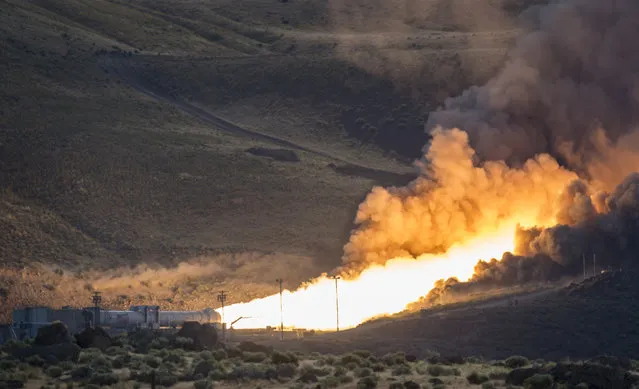
The second and final qualification motor (QM-2) test for the Space Launch System's booster is seen, Tuesday, June 28, 2016, at Orbital ATK Propulsion Systems test facilities in Promontory, Utah. (Photo by Bill Ingalls/NASA via AP Photo)

The moon rises ahead of the second and final qualification motor (QM-2) test for the Space Launch System's booster, Tuesday, June 28, 2016, at Orbital ATK Propulsion Systems test facilities in Promontory, Utah. During the Space Launch System flight the boosters will provide more than 75 percent of the thrust needed to escape the gravitational pull of the Earth, the first step on NASA's Journey to Mars. (Photo by Bill Ingalls/NASA via AP Photo)

The Space Launch System's booster is seen a few hours ahead of the second and final qualification motor (QM-2) test, Tuesday, June 28, 2016, at Orbital ATK Propulsion Systems test facilities in Promontory, Utah. (Photo by Bill Ingalls/NASA via AP Photo)

The booster house is rolled back ahead of the second and final qualification motor (QM-2) test for the Space Launch System's booster, Tuesday, June 28, 2016, at Orbital ATK Propulsion Systems test facilities in Promontory, Utah. (Photo by Bill Ingalls/NASA via AP Photo)

The second and final qualification motor (QM-2) test for the Space Launch System's booster, June 28, 2016, at Orbital ATK Propulsion Systems test facilities in Promontory, Utah. (Photo by Bill Ingalls/NASA)

Spectators watch the second and final qualification motor (QM-2) test for the Space Launch System's booster, Tuesday, June 28, 2016, at Orbital ATK Propulsion Systems test facilities in Promontory, Utah. (Photo by Bill Ingalls/NASA via AP Photo)

The SLS Five-Segment Solid Rocket Motor, that will launch NASA’s Space Launch System and Orion spacecraft to deep space, undergoes a static test fire at the Orbital ATK facility in Promontory, Utah, U.S., in this June 28, 2016 handout photo. (Photo by Bill Ingalls/Reuters/NASA)

A handout image released by NASA on 28 June 2016 shows the second and final qualification motor (QM-2) test for the Space Launch System's booster, at Orbital ATK Propulsion Systems test facilities in Promontory, Utah, USA, 28 June 2016. During the Space Launch System flight the boosters will provide more than 75 percent of the thrust needed to escape the gravitational pull of the Earth, the first step on NASA's Journey to Mars. (Photo by Bill Ingalls/EPA/NASA)

The second and final qualification motor (QM-2) test for the Space Launch System's booster is seen June 28, 2016, at Orbital ATK Propulsion Systems test facilities in Promontory, Utah. During the Space Launch System flight the boosters will provide more than 75 percent of the thrust needed to escape the gravitational pull of the Earth, the first step on NASA's Journey to Mars. Fire and gray smoke billowed from the booster, which lay on the ground during the two-minute test fire in the remote hills of Utah at 11:05 am (1605 GMT). (Photo by Bill Ingalls/AFP Photo/NASA)

The second and final qualification motor (QM-2) test for the Space Launch System's booster is seen, Tuesday, June 28, 2016, at Orbital ATK Propulsion Systems test facilities in Promontory, Utah. (Photo by Bill Ingalls/NASA via AP Photo)
29 Jun 2016 11:32:00,
post received
0 comments
